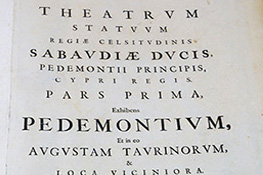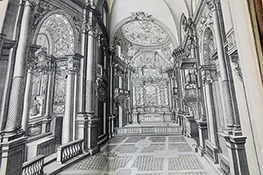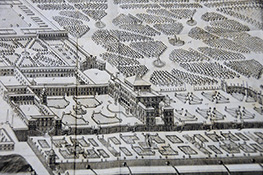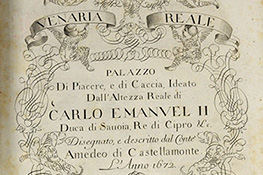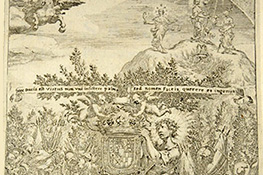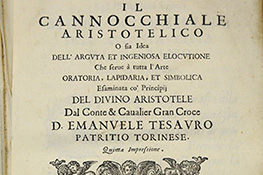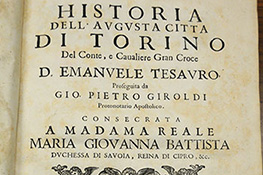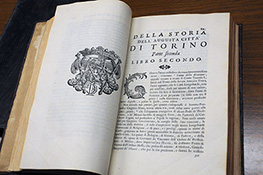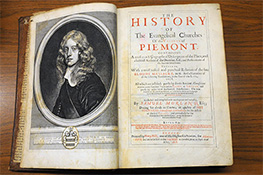Versione italiana English version Version française Versión en español
The trip among the elder books preserved in the Giuseppe Grosso Library goes on with some Books from the 1600s - almost one thousand owned - a lot of which really valuable by a typographic point of view.
Theatrum Statuum Sabaudiae
The most relevant typographic product is for sure the Theatrum Statuum Sabaudiae, a masterpiece in Piedmont typography, a real iconographic monument, an illustrated gather of the mansions, churches and places belonging to Savoia's domains in the end of '600. It is a great publishing enterprise and at the same time a promotional step born as a politic manifest of the duke Carlo Emanuele II di Savoia, to show to the European courts the level of glory and power achieved by his reign. The work started in the '60s of the century and ended in the '80s by the regent duchess Maria Giovanna Battista di Savoia Nemours, the second Royal Lady, and was printed in 1682 in Amsterdam, by the editor and cartographer Joan Blaeu.
Constituted of two great volumes in folio, the Theatrum contains 145 boards, commented in latin, related to the lands of the duchy, that at the time included Piedmont, Aosta Valley, Savoy, Liguria and Nizza. The boards, engraved in copper, mostly on double or triple paper, show geographic maps, topographic plans, and perspective views of Turin and other cities and villages. The drawings were executed by the main artists of that period: Giovenale Boetto, Simone Formento, Federico Guazzo, Carlo Morello and Giovanni Tommaso Borgonio. The first volume includes Turin and most of Piedmont areas, the second the remaining and the centers of Nizzardo and Savoy.
Venaria Reale
The Palace of pleasure and hunt of Carlo Emanuele II di Savoia, designed by Tesauro, was built from 1658 by the architect Amedeo di Castellamonte and described by himself in the famous opera Venaria Reale, printed in Turin by Zavatta in 1674: 99 pages in folio with 64 calcographic boards engraved by George Tasnière, with some hunting scenes and a portrait of the duchess Giovanna Battista di Savoia Nemours dressed like the hunting goddess Diana. The views are designed by Gian Francesco Baroncelli, Jan Miel, by Sanchetti, Branbil and others. It is a precious visual documentation of the royal mansion original look, then partially destroyed by Catinat's French troops in 1693. Rebuilt by Juvarra, damaged during the war, was recently well restored.
The volume, dedicated to the Royal Lady Maria Giovanna Battista di Nemours, duchess of Savoy, Diana non favolosa della regal Venaria, wife of Carlo Emanuele II and mother of Vittorio Amedeo II, has great value and is considered the most beautiful book printed in Italy during baroque age.
The marvelous illustrations include great views of the palace, of the park and the town, with images of sculptures and fountains. There is a particular care for canvas and frescoes that decorated the royal mansion rooms, with a specific reference to "Diana's" room.
Sciences
Between the most beautiful Books from the 1600s preserved in the Library there is for sure the Parnassus Triceps by the surgeon Bartolomeo Torrino, dedicated to Maurizio di Savoia and printed in Turin in 1657 at the famous typography Giannelli. It is a scientific parnassus with a beautiful front page by Giovenale Boetto from Fossano.
The Trattato della peste et pestifero contagio di Torino (Turin 1631) is also a book from another famous surgeon, Gian Francesco Fiochetto, protomedical and archiatrist of Carlo Emanuele I. He was magnificent Rector at the Turin University at the beginning fo the XVII century and one of those who mostly acted to face the plague of 1630. In that year the duchy was crossed by the French, Spanish and Imperial troops and Vittorio Amedeo I had just followed his father in succession line. The plague in Turin caused the death of almost a third of the 25000 inhabitants in few more than a year. Many people escaped the city, included the duke, the court, the ministers and the public officers. There remained only the mayor Gian Francesco Bellezia to rule over Turin with the religious and the surgeons like Fiochetto.
The Compendio della Sfera Celeste by Guarino Guarini (Turin 1675) is really interesting, a small book of astronomical dealings. Architect Guarini was also a theology teacher and published in Paris, in 1655, a huge compendium about his researches in physics, astronomy, philosophy and metaphysics, where he manifested his belief in a geocentric and Ptolemaic universe. In the library there are also many volumes by Guarini about architecture with their drawings.
Literature
There are two beautiful little volumes of poetry, both dedicated to Giovan Battista Truchi, from Carlo Emanuele II court. There is the De passione Domini et obiter de Sancta Sindone in Augusta Civitate Taurini (Turin, 1670), by the latinist poet from Fossano Emilio Malliano. The text talks about Christ's passion in verses composed by the collation of Ovidio's hemistichs. The book's front page has a drawing by Charles Dauphin, engraved by Tasnière. A second engraving shows the dedicatee. The L'anfiteatro del Valore (Turin, 1674) by Pietro Antonio Arnaldo, series of rhymes dedicated to nobles from the court, shows many coat-of-arms and a front page drawing too, all beautiful engravings by Tasnière.
Il Canocchiale aristotelico (Turin, Zavatta 1670, with front page drawing engraved by Tasnière) can be considered the most important treaty about baroque rhetoric. It was written by Emanuele Tesauro (1592-1675), playwright and rhetor from Turin, and it was thought to change the ways of making art just like Galileo's telescope, recalled in the title, permitted to modify the parameters of interpretation of reality. A revolution is so proposed in literature. In the treaty, Tesauro's attention is revolted mostly to the metaphor, fundamental figure of speech which allows to link realities that look separated.
History
Emanuele Tesauro was a highbrow of great prestige, really relevant in the Savoy court, where he worked for more than thirty years.
Between his works, besides the Canocchiale Aristotelico, the Campeggiamenti del Principe Tommaso di Savoia (about the wars of Piedmont against Spain), philosophical operas, tragedies, polemic texts and panegyrics. He also wrote choreographies for parties and ballets and was preceptor of the principles of Carignano and Vittorio Amedeo II, for whom he wrote a gather of fables. Tesauro had a great role elaborating a new image of the duchy and the capital, as we can see in his Theatrum Statuum Sabaudiae. For the capital he wrote the first part of the Historia dell'Augusta Città di Torino, in 1679. After his death, the work was completed by Giroldi in 1712.
The history of Turin by Tesauro preserved by the library is composed of two volumes in folio, printed by Bartolomeo Zavatta. They contain front page drawings printed on a copper matrix and front pages with woodblock letterpress brand, big decorated drop caps and precious typographic friezes. Two illustrations in the text of the second volume are engraved on copper matrix by Tasnière and in the marvelous front page it is represented the map of Turin held by one of the represented characters: in the chart can be noticed the enlargement made by Carlo Emanuele I and the later one in Po contrada.
In the library is also possible to see the controversial Historia di Pietro Giovanni Capriata, (Genova, 1638 and 1649), in two volumes in which are included all the battles in Italy from 1613 to 1634 and then in Italy and out from 1634 to 1644. The second volume opens with an allegorical front page drawing that shows three dogs barking at the moon, with a latin text that refers to the author who wrote the opera despite the barking of ill-thinkers, like dogs barking at the moon. It is an in-depth work about militar history of the first half of '600, with a particular sight to the facts set in Liguria and in Piedmont: Capriata was born in Genoa in the last years of '500, he was defined by Denina the Guicciardini of the XVII century, but was heavily criticized by Tesauro. In Piedmont all the copies of the first volume were seized, since it narrated the facts about the war in Monferrato in a pro-Spanish key. Pope Urbano VIII was also inflexible, since he didn't appreciate that kind of interpretation and the negative words about his nephews cardinals Antonio and Francesco Barberini, and also about cardinal Mazzarino. He did try to obtain the modification of the text.
The Historia largely spread around Italy and abroad, but the critics about Capriata's venality, which could have damaged his fairness, were really hard. The critic from 1700s, besides a generally negative valuation of the 1600s historiography, attributed to Capriata a certain amount of credibility, and Muratori himself took from his work for the 1600s part of the Annali.
In the end two interesting volumes about the history of the Waldensians in Piedmont must be reported: The History of Evangelical Churches of the Valleys of Piemont (London, 1658), by Samuel Morland, with topographic map of the valleys, and Histoire generale des Eglises Evangeliques des Valles de Piemont ou Vaudoises (Leyda, 1669) by Jean Léger, also having an allegoric front page and a topographic map.
Samuel Morland (1625-1695) was an English diplomatic, inventor and cryptologist, who was also famous as a great mathematical and latinist. He projected calculating machines, a portable metal heather, a megaphone, a winch and a device made to encrypt. His hydraulics works were also important. Between his scholars there was Samuel Pepys, who would have become famous for the diary. Moreland was credited at the court of Carlo Emanuele II to lodge an appeal in favor of the evangelic churches of the valleys in Piedmont and during this stay he wrote the book.
Jean Léger (Villasecca, Val Germanasca, the second of February 1615 - Leyda, 1670) was a reformed pastor in Prali, Rodoretto and San Giovanni, moderator of Waldensians churches and pastor of the reformed church of French language in Leyda. Protagounist and witness of the Waldensians massacre (the so called Pasque Piemontesi, April the 25th-27th 1655), he gave one of the first historiographical reports of the fact in the two volumes of his book, for which he was considered one of the main Waldensian historical of the 1600s.

